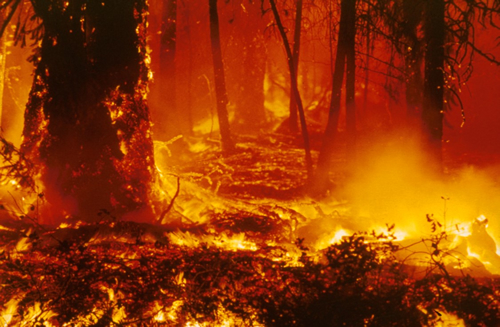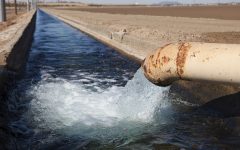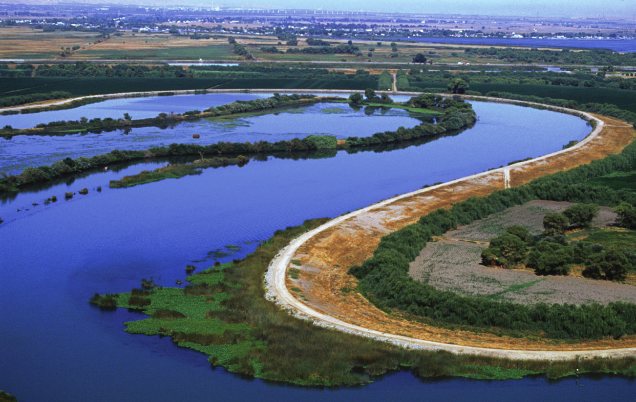
Ringside: The Fire Next Time
The scale of the ongoing tragedy in Los Angeles County defies description, but it doesn’t have to happen again
By Edward Ring, January 16, 2025 11:43 am
Given our mission to review and recommend water and energy policies and projects, it would be negligent to ignore the horrific firestorms that have torn through Los Angeles County. And before beginning, we must acknowledge that no amount of preparation can entirely prevent tragic outcomes when 100 MPH winds turn the urban canyons of Southern California into a blast furnace. But here are some ideas local elected officials and other individuals in positions of local and regional influence may consider to make their neighborhoods and cities better prepared for the fire next time.
1 – Contact state legislators and urge them to support legislation that streamlines the approval process for projects that deliver more water, and to repeal legislation that deters investment in more water infrastructure. In particular, urge state legislators to either repeal the California Environmental Quality Act (CEQA) altogether, or at the least, take away the right of 3rd party private attorneys to file lawsuits pursuant to CEQA.
2 – Urge legislators to repeal SB 1157 and related legislation that enforces permanent water rationing on California’s households and businesses. It’s bad enough that this intrusive law will squander an estimated $7 billion to save a scant 440,000 acre feet of water per year. But its ultimate impact will be to slow if not stop efforts by urban water districts to increase their supply capacity. And that is dangerous. Under countless disaster scenarios for which we may have no advance notice, stripping all surplus out of our capacity to store, treat, and distribute water can have devastating consequences.
3 – Work with local fire department officials to identify fire prone neighborhoods and adjacent open space and send crews in once per year to clear out overgrown fuel. The procedures to do this are well established; we just haven’t done enough of it. Fast track the approval process (hours, not months) for applications to perform the work. To secure ample funds to do this, year after year, replace “permanent supportive housing” programs with cost-effective congregate shelters. That should free up millions, if not billions. Then use all available tools and techniques to reduce overgrown vegetation – goats and other grazing animals, prescribed burns, and mechanical thinning.
4 – Bury the power lines. All of them. Everywhere. Secure state and federal funds to help pay for it.
5 – Revise building codes to improve the many standards that already exist to protect homes against wildfires. Eliminate combustible exteriors, install windows with tempered glass, require fire resistive roof underlayment, non-combustible fences and decks, closed attics, or attics with ember-resistant vents that are sprayed with fire retardant interior coating. And so on.
6 – Encourage private residential pool construction with the condition that they include, as one well prepared homeowner recommends, “a 3–inch suction line in the deep end with a standpipe at the street to allow firefighters a guaranteed source of water.”
7 – Embrace the concept of resilience instead of retreat. California has the highest urban density in the United States at 4,790 per square mile, at the same time as only 5 percent of California’s land is urbanized. Fire risk in the urban-wildland-interface should inspire us to prevent fires and withstand fires in these areas, not impel us to withdraw into increasingly dense urban cores.
8 – Resist the regulatory assault on permeable surfaces that percolate runoff, transpirate valuable moisture into the atmosphere, and reduce urban heat island impact. For example, tear up artificial turf and replant grass on athletic fields. Instead of forcing homeowners to kill their lawns, simply ban use of pesticides and herbicides on lawns. We are not taking advantage of the potential for well-hydrated urban landscapes to increase humidity and resist ignition.
9 – Work with Explorer Scout troops, homeless services, county corrections officials, community colleges, local fire departments and other community organizations to recruit and train a firefighting reserve corps. Drawing on well-established criteria for training volunteer fire brigades, but scaled up, create an army of firefighting reservists that undergo annual refresher training and are on call whenever disaster strikes.
10 – Reimagine firefighting and fire prevention to save money and improve results. Work with private and public fire agencies and private entrepreneurs to procure and test not only systems to remotely detect small fires before they become big fires, but also next generation technologies such as water carrying, firefighting drones, and autonomous robots designed to march into canyons to cut and remove brush. There is no reason why small cities and agencies cannot have someone looking into these opportunities and make small investments. Accelerating the development of these innovations may be the final decisive step necessary to make the experience of cataclysmic wildfires recede into history.
Local elected officials and other influential individuals can do a lot to make sure that next time, the fires have less fuel to burn and the firefighters have more resources to contain them. Working collectively, local authorities can pool sufficient political, financial, and legal resources to defy and dismantle the thicket of laws, regulations, bureaucracy, and vested interests that have undermined our ability to prepare for and respond to fires.
This is a moment to recognize that however well-intentioned they may be, environmentalist-inspired policies in California have created water and energy scarcity, which translates directly into having less capacity in our cities to deliver the resources needed to fight fires. This same unbalanced and often extreme environmentalism has informed policies and regulations that denied us the opportunity to responsibly manage California’s forests and proactively clear the brush out of our urban canyons.
The scale of the ongoing tragedy in Los Angeles County defies description. But it doesn’t have to happen again.
- Ringside: CA GOP Just Blew $46 Million for Nothing – Here’s How They Can Avoid Repeating That Mistake in 2026 - December 24, 2025
- Ringside: Will the Delta Pumps Operate at Capacity this Winter? - December 18, 2025
- Ringside: Will Advocates for More Water Supply Projects Find Unity? - December 11, 2025





All good suggestions. I like number 6. The author brings up the high density of housing but we also must stop the zoning that is forcing ultra high density housing that makes it nearly impossible to evacuate areas when needed. The bottom line though is we must force out the satanic cabal and their minions that are burning the state to the ground by design. All the current polices are designed to exacerbate the problem. Recognizing that this is all part of Newsome’s plan for the state is the first step.
PGE and SCE should be required to bury ALL power lines: Suggestion #4 and NO RATE INCREASES FOR DOING THIS. Here is video from a doorbell camera showing that the Eaton fire started adjacent to SCE power lines:
https://youtu.be/lrp4F0cYfJU?feature=shared
You have absolutely no idea of how much that would cost. 25 years ago the cost to U.G. power cables was at a minimum double the cost of O.H. distribution. No utility could possibly absorb the cost without passing those costs onto the customer.
The video in the link is about the progress of a fire, not the cause of a fire. Suggestion #4: To place all existing distribution lines underground would be prohibitively expensive, and there’s not enough money in the whole universe to place transmission circuits underground. The investor owned utilities would be more than happy to place distribution circuits underground as they are cost plus outfits, and the more money flowing through their fingers the more investment returns to stockholders. However, someone else has to pay for it. So to pay through the rate base or through the tax base is akin to making a choice to pay through either Peter or Paul, but either way the ratepayer/taxpayer is going to foot the bill. It’s better to force politicians and bureacrats to clear excess vegetation fuel and beat down the envirofascists who prevent it.
The rate payer is the victim of lousy management at all corporate and government levels. There are already ways available to pay for this process that rate payers are already being charged for……Move the funds from those and prioritize fire mitigation:
Kevin Kiley
@KevinKileyCA
I am introducing legislation to prohibit states from using Medicaid funds on illegal immigrants. California is currently spending billions each year for this purpose. Those funds would be better used on wildfire prevention, to take one example.
https://x.com/KevinKileyCA/status/1880291612200521864
In the middle 80s there was a new yet small, isolated tract of housing having a view of the mountains with a 66kv transmission line with 12kv distribution underbuild at the front of the tract. The 12kv was placed underground but the 66kv remained overhead with new poles. Someone associated with the tract, dunno if it was the builder or a group of irate homeowners in the tract, contacted the power company with the demand that they paid to have everything put underground and they wanted it to be so. The power company replied that no, the tract paid to have the underbuild put underground but if they wanted the transmission put underground also the power company would be happy to do so, but the going rate at the time started at $1million a mile. The 66kv remained overhead. Overhead distribution is fine just so long as everyone does their part – the electrical structures are maintained and the state and local governments see to it that the fuel is removed, just like it used to be.
As far as the city of Los Angeles concerning the criminal neglect and outright malfeasence, the city needs to be divested of the utility DWP. It doesn’t matter if sce, sdg&e or some other entity picks it up, city of LA needs to have the utility taken away from them. I think it’s preferable that the water and electrical divisions are sold separately. I have little knowledge of MWD, but maybe that would be way preferable to city ownership.
How about moving forward with more of a volunteer fire fighting force, like other fire prone western states. Let’s make our money go farther.
Since in California, 95% of fires are caused by humans, ban outdoor camping except in designated spaces in local and state parks, effectively ending homeless encampments. In LA, 7/10 calls are to homeless encampments on fire and drug OD calls. Firemen need to fight fires.
Immediately build water storage facilities authorized by the taxpayers, and end environmental regulations which allow most fresh water runoff to the sea.
Ban all travel by elected officials out of state during times of high fire danger.
You’ll learn a LOT about this mess you may not have known before if you watch this fascinating and compelling interview of Michael Shellenberger (by Tucker Carlson). Long but worthwhile:
“Tucker Interviews Michael Shellenberger about L.A. Area Fires”
https://x.com/TuckerCarlson/status/1878956242418168193
Thoroughly disrupt the drug trade and force mentally ill homeless to undergo treatment, and aggressively clear underbrush and other vegetation that fuels fires.
#3 There were some california communities that were using goats to clear brush, but that practice was killed in much the same way independent truckers, fast food restaurants and enterpreneurship are being killed now. Need to change out politicians and smack down the bureaucracy.
Mr. Ring,
I just finished watching your interview with Mike Rowe. “The way I heard it”
It was a really good watch, I thoroughly enjoyed it! In fact, I watched it twice. You have great ideas!
My question is, what needs to be done to make these things happen?
I live in Utah and just between you and me; i don’t want any more. Californians moving here. There’s too many people already. =)
Thank you